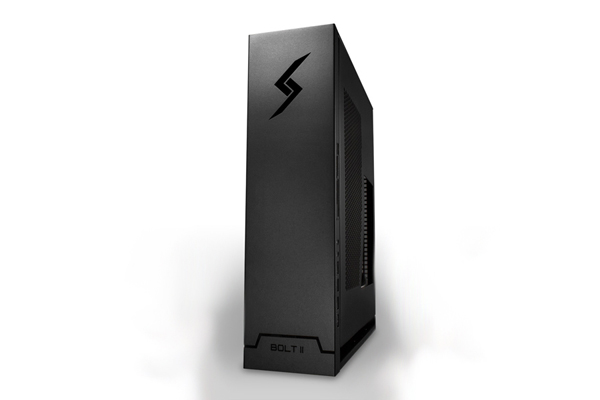Tom's Guide Verdict
The Digital Storm Bolt II is a sleek, powerful and highly customizable gaming desktop.
Pros
- +
Attractive and slim
- +
Strong gaming performance
- +
Easy-open chassis
- +
Detailed temperature controls
Cons
- -
Starts out noisy
Why you can trust Tom's Guide
Sporting an attractive chassis with powerful parts tucked beneath, the Digital Storm Bolt II is a small-form-factor gaming desktop that aims to deliver big power. This versatile tower ($2,664 as reviewed, $1,725 starting price) packs a speedy Intel Core i7 processor, a robust Nvidia GeForce GTX 980 graphics card and an elegant chassis built for maximum ventilation and high upgradability. The Bolt II is built to do it all for gamers, and it does just that.
Design
Slim, jet-black and wonderfully rectangular, the Digital Storm Bolt II is feature-rich enough for your command center yet sleek enough to sit in your living room disguised as a gaming console.
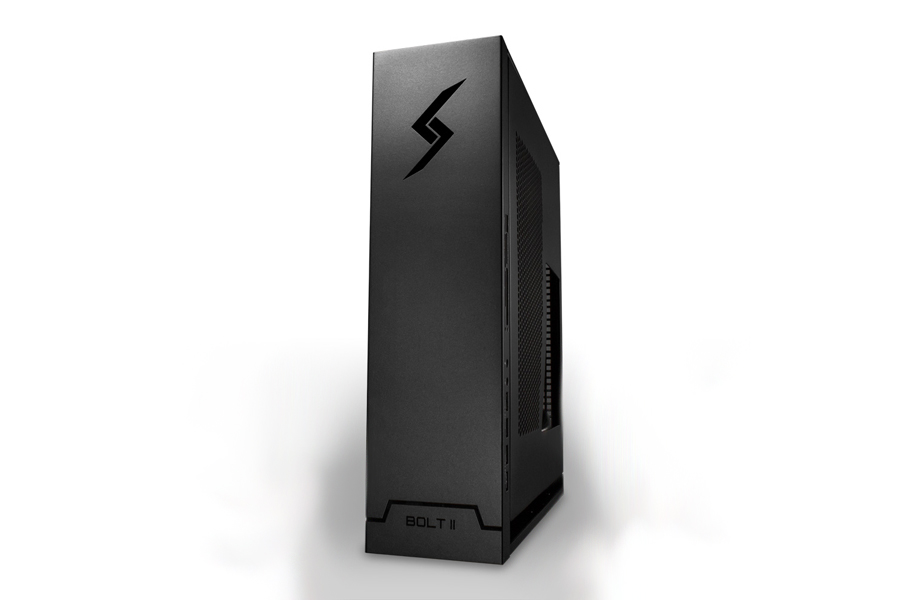
When standing upright like a traditional tower, the Bolt II sports a big, red Digital Storm logo at the top of its front panel and a DVD-R/RW drive in the middle. All of the ports you'd want quick access to — such as headphone, microphone and USB 2.0 and 3.0 — are conveniently right around the corner, on the right edge.
MORE: Best Gaming Desktops Available Now
Also on the right panel is a large vent, placed next to a glass window that lets you peek at the machine's cooling system under a bright fluorescent glow. The top edge houses the PC's power button, as well as a vent that allowed me to see the glowing, green GeForce GTX logo on the GPU beneath. There are four rubber bumpers on the machine's left panel, which you can use to lay the Bolt II flat like a supersize game console.
All of these vents and windows create a design that's as easy on the eyes as it is on your desk space. At 16.4 x 14.1 x 4.4 inches, the Bolt II is notably unassuming compared to, say, the Lenovo Erazer X510, which has a much larger 20.3 x 7.2 x 17.5-inch footprint and a bulkier, more angular build. However, at roughly 30 pounds, the Bolt II is notably larger and heavier than Alienware's X51 small form factor desktop, which measures 13.5 x 12.5 x 3.7 inches and weighs 12.1 pounds.
Ports and Expandability
The Bolt II packs just about every port you need to properly enjoy games, starting with two USB 3.0 and three USB 2.0 inputs in the front. Also located in the front are both SD and microSD card readers, an MS memory stick reader, an XD slot and a CF/MD port.

On the back of the unit, you'll find four USB 3.0 ports, three USB 2.0 ports, a USB BIOS Flashback port and a PS/2 port for non-USB mice and keyboards. The machine's HDMI, DisplayPort, VGA-out and DVI slots will satisfy your video needs, while the line-out, line-in, S/PDIF out and mic-in ports will do the same for audio.
The Bolt II's GeForce GTX 980 GPU packs an additional DVI port, HDMI port and three DisplayPorts, allowing you to get extra-immersive with multiple monitors.
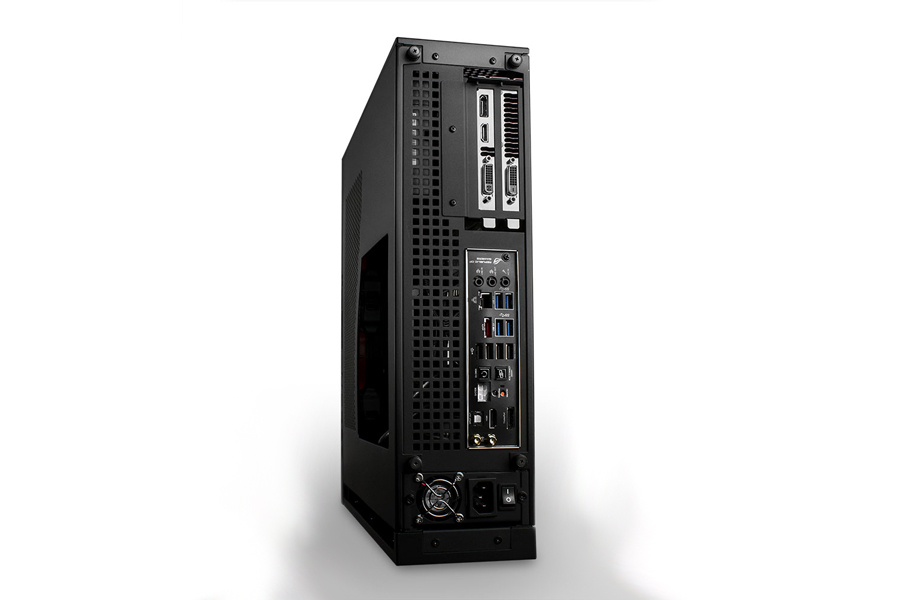
The desktop sports tool-free thumbscrews on the backside, allowing you to easily remove the left and right panels to swap out the PC's graphics card, storage drives and cooling system. After a few seconds it took to unscrew the screws holding together each side, I had no issues removing the left and right panels and popping them back into place.
Graphics and Gaming
Outfitted with Nvidia's juicy GeForce GTX 980 GPU, the Bolt II effortlessly tore through some of today's most graphically rich games.
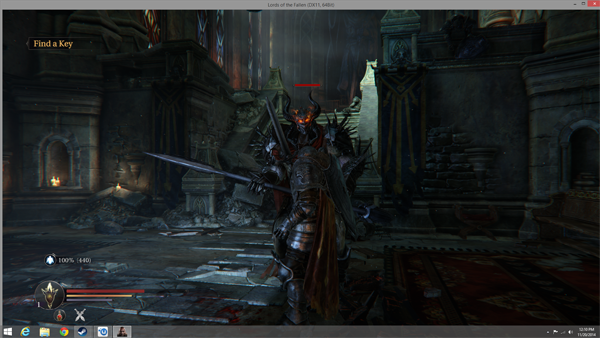
When playing action-role-playing game Lords of the Fallen at 1080p with graphics set to very high, I dodged attacks and stabbed enemies at a smooth 60 frames per second (with occasional dips to 45 fps). The system's GPU did a fine job of rendering the dust particles that floated through dungeons, and I got a crisp view of my character's face tattoos and facial veins.
MORE: Best All-in-One PCs
Notably demanding shooter Metro: Last Light also played wonderfully on the Bolt II, offering strikingly realistic lighting and tons of fine detail, down to the black facial stubble on my teammate's face. The action ran at an ultrasmooth 151 fps at 1080p with graphics set to low, and remained at a highly playable 48 fps on high. By comparison, our Erazer X510's GTX 760 GPU notched 94 fps on low settings and a not-very-playable 23 fps on high.
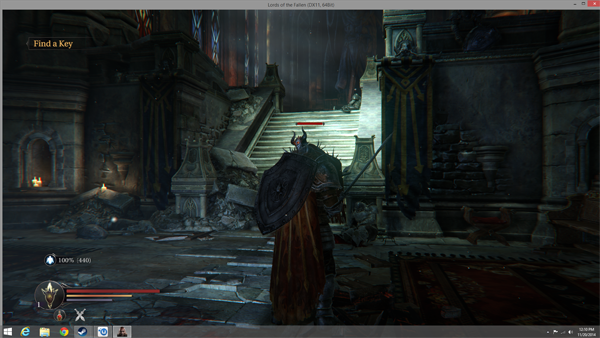
The Bolt II scored an epic 179,082 on the 3DMark Ice Storm Unlimited test, beating the Erazer X510's 145,924 and crushing our overall desktop PC average of 55,476.
The desktop's Cinebench OpenGL rating of 87 wasn't quite as high as the X510's 128.41, but the Bolt II still trumped the desktop average of 60.
Performance
Packing a 4-GHz Intel Core i7 4790K processor, the Bolt II has enough multitasking muscle to breeze through games, movies and productivity tasks all at once. I played some more Lords of the Fallen while simultaneously running a full system scan, streaming a movie on Netflix and downloading a digital copy of Titanfall, and didn't notice the slightest bit of slowdown.
The Bolt II racked up 17,623 on the Geekbench 3 general performance test, besting the Core i7-4770K-powered X510 (14,799) and more than doubling our 7,543 desktop average.
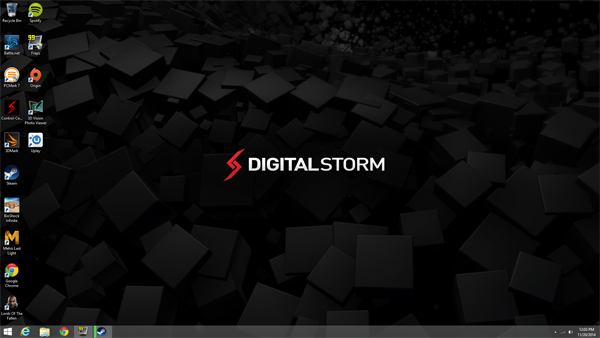
As far as productivity goes, the Bolt II took 2 minutes and 55 seconds to match 20,000 names to their addresses in OpenOffice. The Digital Storm desktop was a bit faster than the X510 (3:20), and much faster than the 6:24 desktop average.

The Bolt II's 1TB, 7,200-rpm hard drive (backed by 120GB of flash memory) took just 40 seconds to copy 4.97GB of mixed media, for a speedy transfer rate of 127 MBps. This wasn't quite as fast as the X510's 170 MBps (using a 1TB hard drive), but it's far quicker than the 76 MBps desktop average.
Controlling Noise and Heat
In order to blow away accumulated dust and sync with the system's HydroLux control board, the Bolt II's 240mm lets out a pretty loud whir when you first turn on the machine. Fortunately, the PC's 240mm liquid cooling system keeps things pretty quiet after that, and the system provides precise control over temperature and noise via the preloaded HydroLux Control Center App.
The Control Center offers three different types of fan optimization: Extreme Mode cranks up the noise in favor of maximum performance, Quiet Mode does the opposite and Auto Mode adjusts on the fly to whatever task is being thrown at it.
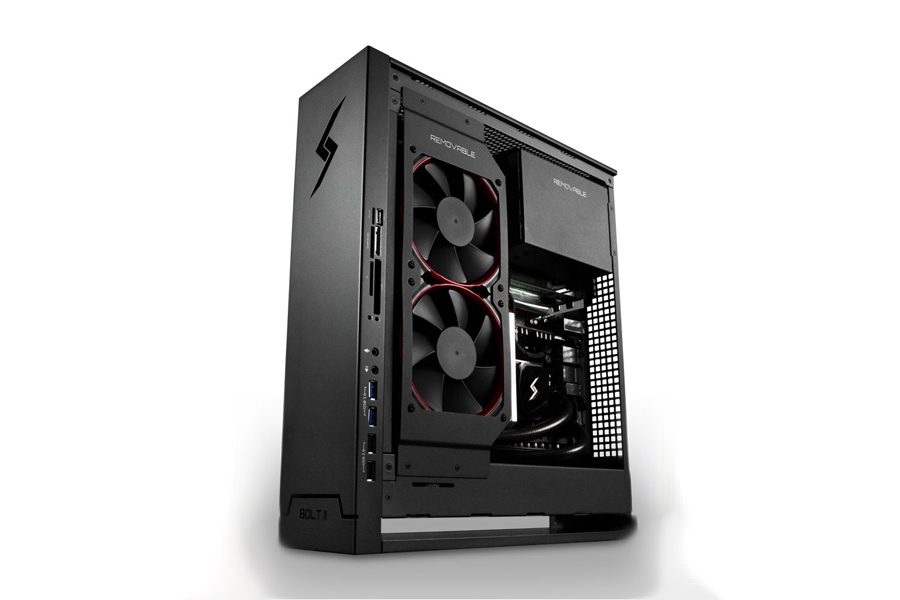
I found Auto Mode and Quiet Mode to be almost identically silent, even when I tore through Lords of the Fallen and BioShock Infinite using the former. Extreme Mode's steady whir might get on your nerves if you're in a quiet environment, but if you're the type to crank up your speakers or use headphones, you won't have a problem.
Control Center provides an exhaustive real-time breakdown of the Bolt II's temperature data, including the temperature of the machine's fluid, CPU, GPU, hard drive and exhaust. After 20 minutes of slaying monsters in Lords of the Fallen on Auto Mode, the CPU temperature rose to 100 degrees Fahrenheit and the GPU to 95 F. Most of the machine stayed cool to the touch after this session, save for the top of the rear panel where the processor and graphics card are located.
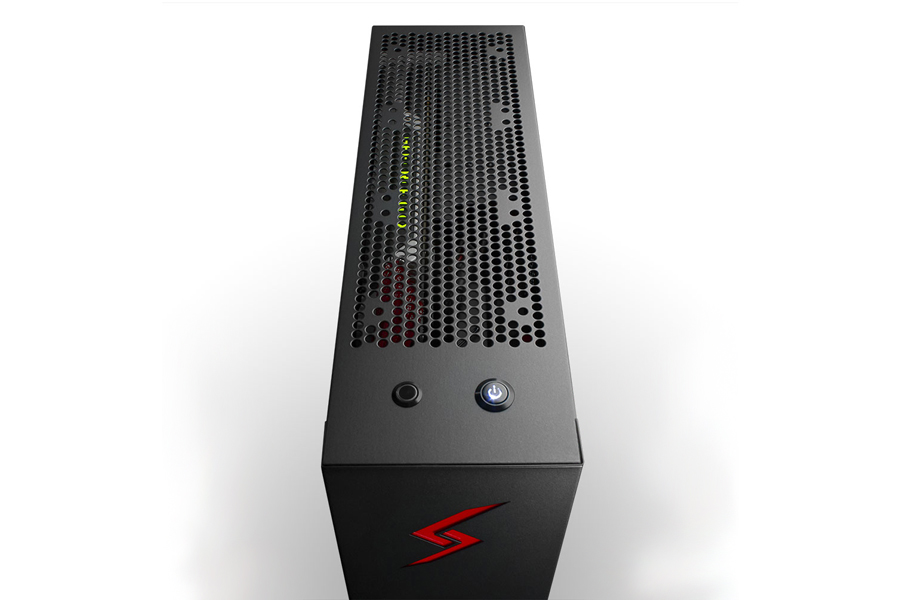
To help you keep track of your machine's temperature in the midst of battle, Control Center's LED Thermal Mode will automatically adjust the color of the system's lights from an icy blue to a warm red based on heat. After another 20-minute Lords of the Fallen session, the lights never went past green.
GeForce Experience
As with any Nvidia-powered gaming rig, the Bolt II comes loaded with the GeForce Experience software hub. This app lets you download new drivers, get a quick glance at your machine's specs and automatically optimize each of your games' graphics settings with a single click.

You can use the software's ShadowPlay function to record your gameplay, or stream it live to Twitch. If you have an Nvidia Shield Tablet or Shield Portable, you can use the app's GameStream function to stream PC games like Titanfall, BioShock Infinite and Dark Souls 2 to the small screen.
Configurations
The Bolt II starts at $1,725, which includes an Intel Core i5 4590 processor with 8GB of RAM; an Nvidia GTX 760 GPU; a 1TB, 7,200-rpm hard drive with 120GB of flash memory; a 500W Digital Storm power supply; and an ASUS H97 motherboard. Stepping up to the $1,952 model will get you a Core i5 4690K CPU and a better GTX 970 GPU, with the rest of the specs remaining the same.

We reviewed a $2,664 version of the Bolt II, which packs a Core i7 4790K CPU; a GTX 980 GPU; 16GB of RAM; a 1TB, 7,200-rpm hard drive with 120GB of flash memory; a 500W power supply; and an ASUS Z97 motherboard.
MORE: Hot Gaming Keyboards
If you want to go all out, the $4,233 Battlebox Edition packs an Nvidia GTX Titan GPU, 250GB of flash storage, a 700W PSU and a Blu-ray combo drive within a slick copper chassis, with the rest of its specs largely resembling our unit.
Everything from the Bolt II's color to its CPU and cooling system can be customized using the configurator on Digital Storm's website.
Digital Storm Bolt II vs. Competition
One of the Digital Storm Bolt II's closest small-form-factor rivals is the Alienware X51, which starts at a much cheaper $700 but has a weaker Core i3 processor and GeForce GTX 745 graphics card. The machine costs $1,600 maxed out, which bumps the CPU to Core i7 and adds in a GTX 760 Ti GPU.
Both machines are designed to be small enough for both your desk and your entertainment center, but the X51 has the advantage of being compact and light enough for you to carry it around the house without straining yourself. If upgradability is a priority, the Bolt II's easy-open panels and numerous swappable ports win out.
Bottom Line
The Digital Storm Bolt II ($2,664 as reviewed, $1,725 starting price) succeeds at delivering beefy performance while retaining a relatively compact and versatile design. Its Intel Core i7 processor and Nvidia GeForce GTX 980 GPU pack all of the power you need to play today's most demanding games, and its attractive chassis is easy to pop open when you're ready to upgrade components.
If top performance isn't a priority, you can save some cash (and desk space) and go with the more compact $700 Alienware X51. But if you're looking to hit a sweet spot between power, style and customizability, the Bolt II more than delivers.
Mike Andronico is Senior Writer at CNNUnderscored. He was formerly Managing Editor at Tom's Guide, where he wrote extensively on gaming, as well as running the show on the news front. When not at work, you can usually catch him playing Street Fighter, devouring Twitch streams and trying to convince people that Hawkeye is the best Avenger.
-
FranAmestoy Im a total noob in all this buzz regarding Gaming Pcs, the most powerful machine to play I have is an iPad, so I'm interested in moving from my Vaio Dual Core laptop to a super-highest-end gaming spaceship, that's why I found this article very interesting.Reply
However, it filled me with questions, hope you can lend me a hand.
Is the difference noticeable when playing at more than 30 fps? I mean, I got a little concerned about how much gap existed in your tests, from 45fps to 151fps when playing Metro: Last Light. Those high graphics really beated up the PC's specs, so is the difference that evident to your game?
What's the point on spending that money in the best in the world PC for gaming, if it's going to suffer when cranking up the game options, hence lowering the performance?? Or should I really don't get worried because 45fps mean "extreme good playing experience"?
